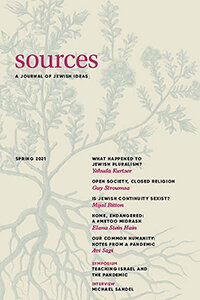Editor’s Comment
Jews have long insisted that ideas — and vigorous contentions over ideas — are a necessity of life. We all move within a long tradition which has taught us that by debating ideas we can tap into the great energies of our heritage, offer a more coherent vision of who we are, and carry forward the long procession of Jewish experiences. Now more than ever, in this sorely tested time of public disorder and private bewilderment, a time that substitutes rhetoric for knowledge and loud assertions for learning, we need ideas not to cater to any passing need for entertainment, but to vivify our comprehension of ourselves and to guide us toward what is most enduring for us and our communities. We have too many tweets and social-media posts and op-eds and too few homes for well-crafted essays.
Our vision for this long-form journal is simple: an accessible forum for informed and informative conversations about Jewish ideas, hospitable to divergent views, in the form of a many-branched dialogue. Sources will treat ideas not as positions to be taken or defended but as precious possessions.
The journal is also something of an anomaly. Published by the Shalom Hartman Institute, a leading center of Jewish thought and education in Israel and North America, Sources enjoys editorial independence. It is neither a commercially compromised exercise in public relations nor beholden to ideological pieties of one stripe or another. Instead, it aims to join the rigorous with the personal, passion with intelligence, moral thinking with political purpose, an urgency about the present moment with a trenchant sense of historical perspective. This dual dialogue — with past sources and with present realities — also represents an open-ended experiment, a work in progress. If we’re lucky, the whole will transcend both its editors and its individual contributors.
Above all, like storied journals of the Jewish past, Sources clamors to go beyond the immediate subject to larger questions of our common culture. This task, nearest to the journal’s purpose, is admittedly elusive. It isn’t enough to gather together a stable of gifted writers — those who are already well known and those who ought to be. It’s a matter of recognizing how many of modern Jews’ boldest ideas were articulated and carried forward in their periodicals. Ahad Ha’am’s Hashiloach, founded in 1896, brought forth the revival of Hebrew literature from Odessa. Martin Buber’s Der Jude, launched in Berlin during the First World War, gave bold voice to the leading lights of German-speaking Jewry. The Menorah Journal, breathed into life in 1915 by a circle at Harvard dedicated to promoting an American Jewish humanism, hosted some of the most stirring writing in the country. (“It seems to me,” Lionel Trilling wrote in 1929, “that the whole purpose of practical Jewish endeavor is to create a community that can read the Menorah Journal.”) Each asserted an influence disproportionate to its modest circulation. So too, we’ll measure the cultural sway of Sources not by the size of its press run but by the reach of its ideas.
In our day, this journal — like its illustrious forebears — is both an act of faith in the creative possibilities of the Jewish imagination and an invitation to take delight in remaking those possibilities. This is the resource from which Sources draws; this is the “pleasure principle” to which it is dedicated. We hope it will strike a responsive chord.
This article appears in Sources, Spring 2021




